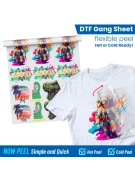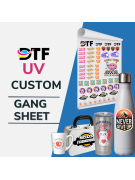Types of DTF Inks

CONTENT
Just as there are different types of printing techniques like DTF transfers and sublimation transfers, there are also different types of inks used to create a wide variety of designs on clothing, metallic surfaces, wood, ceramics, etc.
Although only certain kinds of inks can be applied for a specialized technology such as DTF transfers or direct-to-film transfers, since 2019 it has positioned itself as the solution for textile printing due to its easy application that saves time, minimizes effort, and enhances efficiency.
If you are a small or a start-up business in the making you need to understand each part that comes with choosing to trust a DTF transfers provider or purchase a DTF device. Because of that, our team has prepared the following article so we can share with you all about the properties and benefits of the different types of DTF inks.
Differences between regular inks and DTF inks
The main purpose of DTF inks is to bring designs to life by adhering its components to a heat-sensitive film sheet, which, after drying and cured, is then transferred to a large range of fabrics that can then be transformed into exclusive merchandise, athleisure, custom t-shirt, hats, and so much more.
As a result, regular inks by any means can not be applied during the DTF transfer process. Not only are they designed for paper print only, but they also can not resist high temperatures, water contact, stretching, cracking, and peeling; and in some cases, they can affect the internal mechanism of a DTF printer.
If you want to reproduce high quality detailed designs in a large spectrum of colors without the fear of fading, using the proper equipment has to be at the top of your priority list. DTF inks are manufactured using highly pigmented components with the sole purpose of creating designs that last longer regardless of factors such as mobility, weather, and temperature.
Properties of DTF inks
Unlike standard inks with low resistance and durability, the compatibility of the DTF inks with this printing technique provides a large amount of benefits. Such as the possibility of developing intricate and vivid designs with a few primary colors like yellow, magenta, cyan, and basic black and white inks.
They are also suitable for various types of fabrics, including cotton, polyester, blends, and more. And if you're concerned about these inks fading or having any adverse effects on the environment, rest assured that the majority of these types of inks components make them highly water-resistant, with exceptional adhesion properties as well as environmentally conscious.
Types of inks used in DTF printing
DTF inks are especially designed to be compatible with DTF techniques enhancing the overall quality and visual appeal of the transferred designs, making them stand out. Here are some of the direct to transfer inks that have opened up new creative possibilities for the textile industry since 2019 .
1.- UV DTF Inks
Printing designs with vibrant and accurate colors is one of many guarantees shared by all DTF inks, although much of this depends on the quality of products sold by your supplier. However, a characteristic unique to UV DTF inks is their ability to cure rapidly when exposed to ultraviolet light.
On a large scale, this means an improvement in production efficiency and workflow in UV DTF transfers, perfect if you want to focus your business on the customization of promotional items such as mugs, wine glasses, signs, notebooks and more! With these kinds of inks, it will be possible to produce personalized designs and print them in a fraction of the time, allowing you and your team to meet tight deadlines and high-demand requirements more effectively.
Consequently, the ability to swiftly create and print personalized designs enhances customer satisfaction and brand recognition by delivering quick orders without compromising on quality.
2.- Water-Based DTF Inks
As the name suggests, these inks are primarily made with water-soluble components. This makes them environmentally friendly and easier to clean up compared to other inks. However, this also means less water resistance and longer drying times.
Their reduced water resistance can make them susceptible to cracking and peeling when exposed to moisture. Additionally, their longer drying times can be a drawback in fast-paced production environments, as it prolongs the time needed for printed materials or artwork to fully set and become usable.
3.- Dye-Based DTF Inks
If you're looking for highly saturated inks, then Dye-based Inks are for you. Their components make them particularly prone to adhering to all kinds of textiles. However, this is only a temporary property since, like water-based inks, they have almost zero water resistance.
In terms of cost, this type of ink tends to lean toward the more pricey side of things. Therefore, if you're looking for printing solutions with a unique temporal effect or a design whose structure you don't mind losing over time, we recommend considering the acquisition of this ink. But if you want a product that guarantees that your logo and design last longer, UV inks will be the best approach.
4.- Solvent-Based DTF Inks
For high-resolution designs with fine details and sharp lines, using solvent-based DTF inks might be the solution. These inks are composed of solvents like oils and alcohol components that act as carriers for the pigments. This composition allows for quick evaporation of the solvent after printing, enabling more efficient production.
Since it is a much more specialized type of ink to achieve the best results possible it is important to follow manufacturer recommendations for ink usage, printing, drying, and transfer processes. Additionally, proper equipment maintenance and handling are crucial to ensure consistent and quality printing.
Remember that some inks might work better with specific DTF printers brands. If your goal is to ensure that your designs are the best in the market, our advice is to seek the support of a DTF transfer provider who will gladly suggest the best type of ink for the design you're seeking. For more information about this topic follow our blog and learn more!





Leave a comment